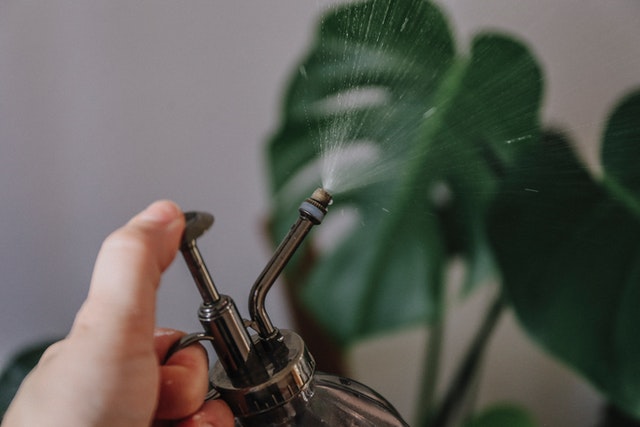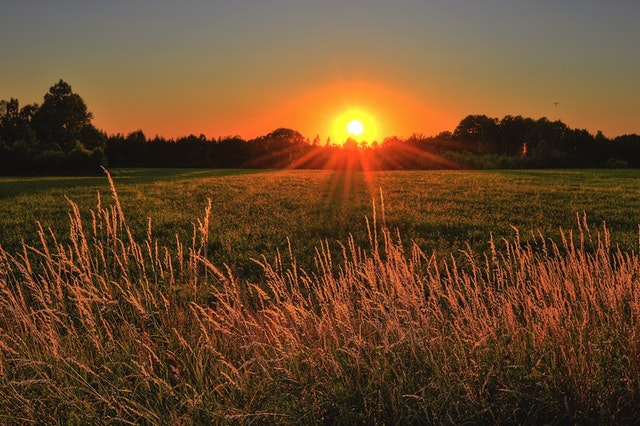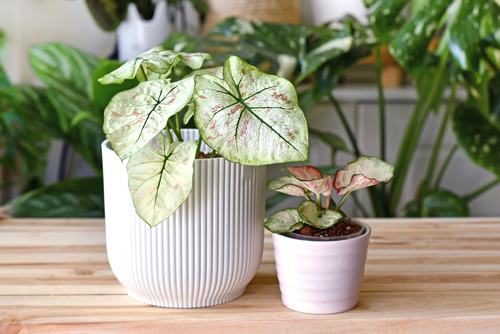Caladium leaves that droop cause gardeners ongoing worry because this could be a symptom of a sick or unhappy plant.
Is your caladium drooping? If so, you might be wondering what you’ve done wrong, and whether your plant is going to die. Unfortunately, drooping is a sign that it might if you don’t take action fast! Caladium leaves that droop cause gardeners ongoing worry because this could be a symptom of a sick or unhappy plant.
Caladiums tend to droop if they get over-watered or under-watered, or if they get too cold. Too much sunlight or too much fertilizer may also lead to drooping. If your plant is looking limp and sickly, check all of these things to see what’s going on.
Caladium Drooping
If your caladium is drooping and looking sad, you should take the time to figure out what’s wrong before you try to solve it. You need to know the root cause before you can start addressing it, or you may make the problem worse.
Unfortunately, quite a few things can cause drooping, so you may have to check several conditions before you can identify the issue. These problems generally include things like too much or too little water, or temperature stress and cold temperatures.
In some cases, drooping may be caused by the plant getting too much sunlight or having access to too much food around its roots. These are less common problems, but still worth investigating.
That’s quite a wide variety of issues that you’ll need to check your plant for, so let’s explore these causes and their solutions in more detail.
Cause 1: Over-watering

One of the biggest causes of caladium drooping is too much water. Because these plants come from tropical rainforests in South and Central America, they do like damp conditions, but these rainforests have dry seasons too – and over-watering is dangerous.
When you water a plant too heavily, you prevent its roots from drying out. If they never dry out, there is a risk of anaerobic bacteria forming around the roots, and attacking the healthy root tissues. The tissues will start to decompose and the roots will rot, preventing the plant from taking in water or nutrients.
It will wilt due to lack of water, even if the soil around it is very wet – because it doesn’t have a root network to access the water with. Having constantly wet roots also deprives the plant of oxygen and makes it stressed.
You can solve this by taking the caladium out of its container, removing any rotten root tissue, and allowing the rest to dry out. The caladium should then be replanted in fresh potting medium, in a clean container, and watered less frequently going forward.
Cause 2: Under-watering
Of course, under-watering can also result in drooping, and is another common cause. Many people underestimate how much water caladiums like, and therefore let them get too dry. When this happens, the plant will droop dramatically, because it doesn’t have sufficient liquid to hold its stems upright.
Being severely parched will kill a caladium, but if you catch your plant in time, you should be able to save it. To thoroughly rehydrate a caladium, you should place it in a basin of water and leave it for 15 minutes.
The water will saturate the pot and soak the roots, and you can then drain the plant and leave it to recover.
Cause 3: Low Temperatures
Sometimes, a caladium will droop because it has been exposed to very low temperatures. These plants like a minimum soil temperature of 70 degrees F and don’t cope well if the temperature drops below 60 degrees F.
If you have your caladiums outside, that means you need to bring them in if a cold snap is likely to occur, or during the winter if you live in a cold country. You should keep them away from windows and AC units if they are already indoors, and make sure they aren’t subjected to any icy drafts.
If your plant has been damaged by cold, you should transfer it to a warm (but not hot) environment and wait for it to recover.
Cause 4: Excess Sunlight

As rainforest plants, caladiums don’t like having a lot of sun on their leaves, and they can wilt quite dramatically if they get too much light. If you’ve placed your caladium on a sunny windowsill or outside in a spot with full rays shining on it for hours, it’s going to droop very quickly.
You will need to relocate the plant or put up a curtain to protect it from further wilting. If you are planting your caladium outdoors, make sure you are putting it somewhere that is shaded during the hottest parts of the day. This will help it to retain its colors, as well as the structure and strength of the leaves and stems.
Cause 5: Too Much Fertilizer
Feeding a plant too much is likely to make it wilt, and if your caladium is looking floppy, you should think about when you last fertilized it. Too much fertilizer will cause a buildup of salts in the soil, and this burns the plant’s leaves and makes them limp.
You shouldn’t fertilize your caladium more than once every few weeks, using diluted fertilizer. If you have given it too much food lately, stand it in the shower and flush the pot out with plenty of clean water. Drain it and it will hopefully recover.
Cause 6: Pest Infestation
Spider mites, mealy bugs, scale insects, and aphids are the most common pests that attack caladium. When they begin to feed on the plant, it’s only a matter of time before its leaves begin to droop.
While these pests are small, you can easily tell if they’ve been attacking your caladium. Constant attention and care will help you notice if these pests have been attacking your plant.
To get rid of pests on your caladium, apply neem oil to the leaves. Additionally, you can also dip cotton wool in alcohol and use it to wipe the pests away. Another effective method is to spray some water on the leaves using a garden hose.
Cause 7: Diseases
Certain diseases can also cause Caladium leaves to wilt. Some of these diseases include Rhizoctonia stem rot, Pythium root rot, and Fusarium wilt.
When the soil is overwatered, it becomes mushy, thereby creating an environment for fungi to thrive. Aside from drooping leaves, diseases can cause the caladium stem to bend and root discoloration.
Separate infected plants from healthy ones once you notice them. Get a commercial fungicide and apply it to every part of the affected plant. Before applying this chemical, read and follow the instructions for use.
Learn more from another post: Why is My Cauliflower Yellow
Summary
Caladium drooping is a common issue that a lot of people face, and trying to figure out the cause can be frustrating. If you are struggling with this, make sure you check each of the 5 potential causes above, particularly the watering levels, and correct whichever has got out of balance. Your plant should soon recover!
Frequently Asked Questions
Why is my caladium drooping?
A likely explanation for a drooping caladium is that the temperatures are too low for it. Caladiums come from tropical places, and they don’t cope well with low temperatures or sudden cold snaps. If the temperature is going to drop to below 60 degrees F, you will need to bring the pots inside overnight.
This should help to protect the plant from the cold, which could otherwise kill it. Be proactive and keep your caladium indoors when temperatures decrease to prevent it from drooping.
How often should I water caladiums?
You should always water plants based on how thirsty they are, rather than a set schedule, because this helps to prevent root rot. However, as a rough guide, most people water their caladiums about once per week. This plant likes to be kept humid and damp most of the time.
To check whether your caladium needs water, push your finger into the surface of the soil and see if it feels wet. If it is dry, the plant needs a drink. If it is still wet to around 1 inch down, wait a while longer so you don’t over-water the plant.
Can you over-water caladiums?
You can give caladiums too much to drink, yes. Like any plant, they are vulnerable to root rot if their roots are permanently wet, so you need to make sure that they dry out a little from time to time. They like to be misted and watered regularly, but not excessively.
If your caladium suffers from root rot, it will die quite quickly, so it is very important to avoid this. Always check how wet the soil is before you give your caladium a drink, and don’t water it if it is still wet.

Hey, I’m Lisa and I’ve been an avid gardener for over 30 years. I love writing, talking and living in the garden! Feel free to connect with me on my socials below


